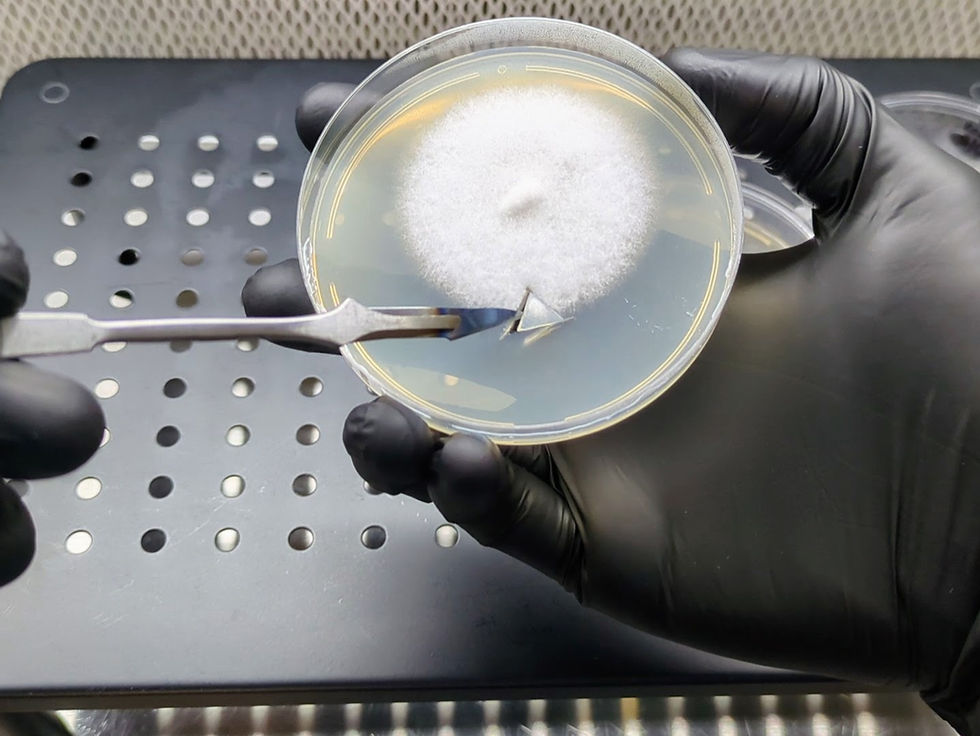The Mushroom Growth Cycle: A Deeper Look
- Harold Evans

- Mar 4
- 3 min read
Updated: Oct 15
Mushroom cultivation is an evolving process that requires a deep understanding of its structured growth cycle. Recognizing these stages enables growers to fine-tune their techniques for more predictable and successful harvests. From the invisible beginnings of spores to the rewarding flush of mature mushrooms, each phase is influenced by a variety of environmental and biological factors that experienced cultivators can manipulate to their advantage.

Stage 1: Spore Germination – The Foundation of Growth
Mushrooms begin their life as microscopic spores, which function similarly to seeds. These spores, when placed in the right conditions, germinate and develop into hyphae, the individual filamentous structures that eventually intertwine to form mycelium—the vegetative body of the fungus.
Key Factors for Successful Germination:
Humidity: Spores require moisture to begin metabolic activity.
Temperature Control: Most species prefer germination temperatures between 70-80°F (21-27°C).
Nutrient Availability: Agar plates, sterilized grains, or even nutrient-dense liquid cultures can provide the necessary sustenance.
At this stage, sterility is paramount, as competing molds and bacteria can overtake young hyphae before they establish a foothold.

Stage 2: Mycelial Colonization – Establishing a Strong Network
Once spores germinate, they form a complex network of mycelium, which expands and consolidates within its growing medium. This phase is crucial for nutrient acquisition and future fruiting success.
Optimizing Mycelial Expansion:
Gas Exchange: Mycelium requires oxygen but remains sensitive to excessive airflow that can introduce contaminants.
Temperature Consistency: Colonization temperatures generally range from 65-78°F (18-26°C), though some species thrive at lower or higher ranges.
Sterile Techniques: Even small amounts of contamination can significantly hinder colonization.
Healthy mycelium is characterized by dense, bright white strands. Weak or patchy growth can indicate inadequate conditions or contamination.

Stage 3: Substrate Colonization – Scaling Up for Fruiting
Once grain spawn is fully colonized, it is introduced to a bulk substrate—coir, manure, hardwood sawdust, or a custom blend—to support further expansion. This stage is essential in ensuring sufficient nutrients and hydration for the upcoming fruiting process.
Enhancing Substrate Colonization:
Evenly distributing spawn ensures uniform colonization and prevents weak spots.
Maintaining substrate hydration promotes faster and healthier mycelial spread.
Growers often observe changes in substrate texture and color, indicating mycelial dominance. Any unusual discoloration or foul odors suggest contamination and may require immediate intervention.

Stage 4: Pinning – The Critical Transition to Fruiting
With proper conditions, the mycelium transitions from vegetative growth to fruiting, forming tiny mushroom primordia known as pins. This is a make-or-break stage, as environmental conditions dictate whether these pins successfully develop into mature mushrooms.
Triggers for Pinning:
Temperature Drop: A 5-10°F reduction can signal fruiting readiness.
Fresh Air Exchange (FAE): Lowering CO2 concentrations through ventilation encourages pin formation.
Light Introduction: Indirect light (6500K spectrum) mimics natural conditions and aids in pin formation.
High Humidity (90-95%): Ensuring adequate moisture prevents pins from drying out prematurely.
Growers often notice an uneven pinset in their first few attempts, but refining environmental controls can lead to more uniform development over time.

Stage 5: Fruiting – Rapid Growth and Maturity
Once pins have formed, mushrooms rapidly expand into their mature structure. This stage requires constant monitoring to maximize yield and maintain quality.
Key Conditions for Healthy Fruiting:
Temperature Maintenance: Species-dependent, but most thrive between 60-75°F (15-24°C).
Sufficient Fresh Air Exchange: Prevents excessive CO2 buildup, which can lead to elongated, weak stems.
Humidity Balance: Maintaining levels between 85-95% keeps mushrooms hydrated without promoting bacterial growth.
The speed at which mushrooms mature varies. Some species, like oysters, develop in mere days, while others, such as shiitake, take significantly longer.
Stage 6: Harvesting and Encouraging Multiple Flushes
Harvesting at the right time maximizes potency and yield. Many substrates can support multiple flushes, but additional care is required to sustain optimal conditions.
Extending Productivity Beyond the First Flush:
Rehydrating the substrate replenishes moisture levels lost during fruiting.
Clearing spent material prevents bacterial buildup and contamination.
Maintaining proper humidity and temperature ensures continued growth cycles.
Though subsequent flushes may yield smaller harvests, they allow cultivators to extend the usability of their substrate and maximize overall yield.
Refining Your Cultivation Skills
Mushroom cultivation is a skill that improves with experience, and understanding the intricacies of each growth stage helps refine techniques for better consistency and higher yields. By carefully managing environmental factors like humidity, fresh air exchange, and substrate composition, cultivators can greatly influence the success of their harvests.
While this guide provides a structured overview, every grower develops their own approach through experimentation. The key to mastery is continuous observation, adaptation, and refinement.




Comments